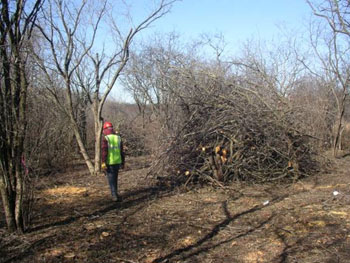Awards
Exemplary Ecosystem Initiatives — 2010
North Chicago, Illinois: Wetland Joint Mitigation Effort
The Illinois State Toll Highway Authority (ISTHA) and the Illinois Department of Transportation (IDOT) partnered in 2006 to rehabilitate 150 acres of native landscape in North Chicago, Illinois. Before the mitigation effort by the two agencies, a layer of invasive shrubs covered the site's native plant species and development was a threat to the site. With the cooperation of the U.S. Army Corps of Engineers (USACE) and the Illinois Department of Natural Resources (IDNR), ISTHA and IDOT were able to rehabilitate and protect the rare prairie and wetland site.

Hand removal of the exotic invasive buckthorn and honeysuckle shrubs
Source: IDOT
As of 2010, only one-tenth of 1 percent of Illinois native prairie remains. The rehabilitation and protection of the North Chicago landscape are important to maintain and protect fragments of this native habitat. IDOT acquired the mitigation site for highway construction in 1966; however, the land was never built upon. Scientists studied the site in 1991, 1996, and 2006 to determine the suitability for wetlands mitigation and the potential mitigation value. During surveys of the area, botanists discovered four State-listed species of plants, which were mapped and documented with Global Positioning System (GPS) and geographic information systems (GIS) tools. Prior to the mitigation project, the exotic species were quantified using digital photographs and HemiView lens to photograph the canopy. The HemiView Canopy Analysis Software measured the percent of visible sky and leaf area index. In addition, field botanists created several horizontal habitat images in order to compare the success of the rehabilitation area after mitigation.
In 1997, the site was approved to serve as a wetland mitigation site, but funds were not programmed at that time. In 2006, ISHTA proposed that the site be used for wetland mitigation for a proposed project. In exchange for land, ISHTA would fund and implement the rehabilitation effort and give half of the land to IDOT. A Letter of Understanding between the agencies was signed. In 2008, ISTHA submitted this site as wetland mitigation bank site to USACE and USACE proposed that ISHTA pursue use as a permittee-responsible wetland site. ISHTA submitted the wetland mitigation plan in 2008 to repair 150 acres of habitat. The wetland mitigation will compensate for 5.3 acres of IDOT project impacts and 10 acres of ISHTA project impacts.
Habitat restoration began in the winter of 2010. Exotic species, such as Rhamnus spp., were cut with hand tools, bundled, and burned onsite. As of September 7, 2010, 91% of the site had been cleared of exotic shrub species. Ongoing restoration efforts will include prescribed fires and herbicides to prevent the spread of the exotic plants. The Floristic Quality Index will be used to measure the floristic quality over a five-year period. To assess the success of rehabilitation, the composition of plant species should comprise the following:
- In the wetlands, 80% of the dominant plant species should be native.
- In the uplands, none of the dominant plant species should be Rhamnus spp. or Lonicera mackii.
The partnership between ISTHA and IDOT and collaboration with USACE and IDNR established a precedent for funding and partnership mechanisms that promotes native landscape rehabilitation. The use of technology tools for measurement and analysis serves as a model for other mitigation efforts. With these data gathering and documentation methods, the monitoring agencies will be able to measure the success of the rehabilitation efforts.
For more information, contact Tom Brooks, IDOT Bureau of Design and Environment, at Thomas.Brooks@illinois.gov or Janis P. Piland, Environmental Engineer, at Janis.Piland@dot.gov.

